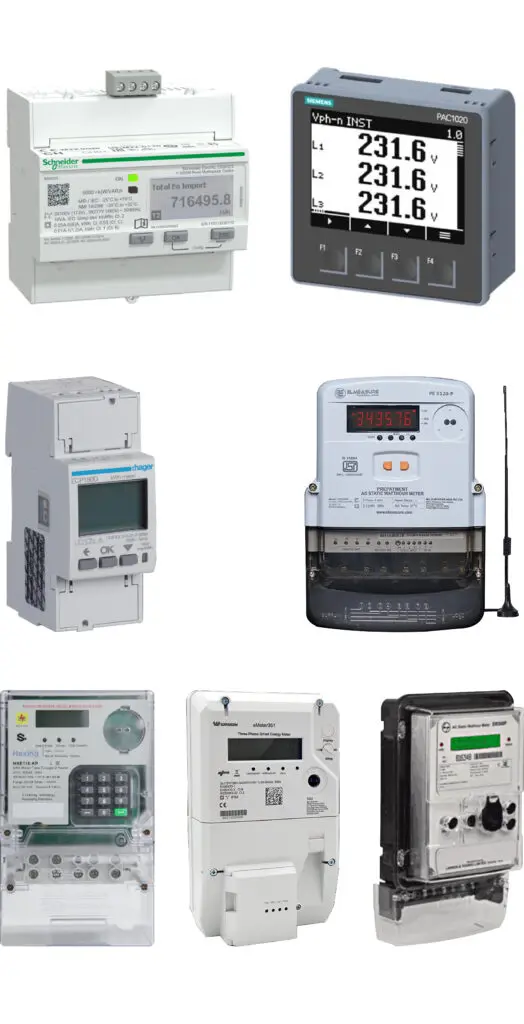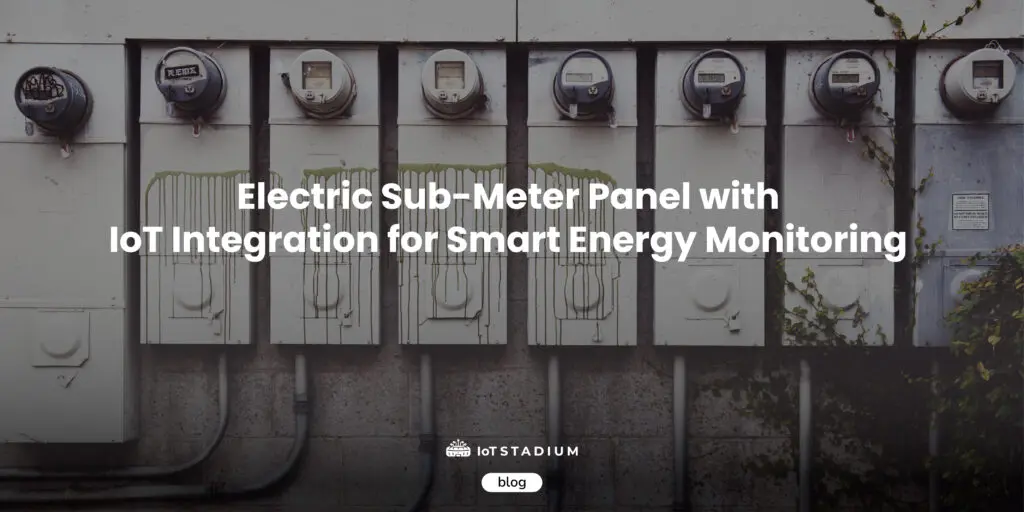Electric sub-meters are becoming essential tools in the push for smarter energy management across industrial sectors. By providing detailed, granular insights into electricity consumption—whether by department, equipment, or process—sub-metering helps companies identify inefficiencies and reduce unnecessary energy use.
As industries continue to expand, the need for precise energy monitoring grows stronger. Rising energy costs, stricter environmental regulations, and global efforts to combat climate change have made energy efficiency a strategic priority.
To meet this demand, the integration of Internet of Things (IoT) technologies with electric sub-meters is transforming how facilities manage energy. IoT-enabled sub-metering systems deliver real-time data, automate alerts, and support data-driven decisions, leading to greater efficiency, lower costs, and more sustainable operations.
What is Submetering?
Electric sub-metering refers to the use of additional meters—called sub-meters—to measure electricity consumption in specific areas, systems, or equipment within a larger facility. Instead of just relying on a single main utility meter, sub-metering breaks down energy usage into smaller, more detailed segments—such as by department, production line, HVAC system, or lighting.
This detailed level of monitoring helps facility managers and engineers gain deeper insights into where, when, and how electricity is being used. As a result, they can identify energy inefficiencies, detect abnormal consumption patterns, allocate energy costs more accurately, and make better informed decisions to improve overall energy performance.
In other words, installing submeters in your building or company lets you achieve more efficient energy management by classifying energy usage.
Different Between Submetering and Metering?
You may wonder, so what is the different between sub metering and metering right?
| Feature | Submetering | Metering |
| Measurement Scope | Total consumption for a property or building | Consumption for specific areas or units within a larger property |
| Purpose | Billing the utility company, overall consumption overview | Accurate billing, energy management, and energy conservation |
| Location | Outside the building or a central location within the building | Within the specific area or unit being measured |
| Data Granularity | Less detailed, provides overall consumption data | More detailed, provides consumption data for specific areas or units |
| Example | Building's main electricity meter | Individual apartment submeter for electricity |
The key distinction between electric meters and submeters lies in their purpose and placement:
- Electric Meters measure the total energy consumption of an entire building. Utility providers use this data for billing and monitoring overall usage.
- Electric Submeters track energy consumption for specific areas, departments, or systems within a building. They enable detailed energy management, cost allocation, and efficiency analysis
Benefits of Submetering and Energy Monitoring
Accurate Measurement
Accurate and efficient measurements are the outcome of electrical submetering. A certain amount of energy consumption estimation is necessary for other energy management techniques. For instance, ratio of utility billing divides utility expenses by a percentage according to variables such as the number of rooms or occupants in a property.
Optimize Energy Use
With electrical submetering, you can keep an eye on every facet of your daily energy use as it happens. This will enable you to develop and put into practice efficient methods for maximizing your energy. The best energy-saving techniques for your circumstances can be found by compiling all relevant data.
Finds Wasted Energy
Electrical submetering can assist you in identifying areas of excessive or wasteful energy use. In the end, this may notify you of issues with your tools, appliances, or several other energy-related devices. You may swiftly resolve any problems by identifying the areas where energy is being squandered.
Device

Here’s a list of commonly available electric submeter devices in Indonesia, including both state-issued (PLN-approved) and commercial brands used for energy monitoring:
State-Issued (PLN-Approved) Submeters
KWH Meter (Kilowatt-Hour Meter) – PLN Certified
-
- Single-Phase (e.g., Mercury Meter)
- Three-Phase (e.g., ABB, Hexing, Itron)
- These are typically used for official billing in multi-tenant buildings (apartments, offices, malls).
Commercial & Smart Submeters (Non-PLN but Widely Used)
These are often used for internal monitoring, tenant billing, and energy management:
-
- Schneider Electric (iEM3255):
Advanced submetering with IoT capabilities. - Siemens (Sentron PAC, 7KM Series):
High-precision energy monitoring - Hager (Enerdy Series):
- Schneider Electric (iEM3255):
Modular submeters for commercial/industrial use.
-
- Elmeasure (ElNet & ElSmart Series):
Popular for real-time energy tracking. - Hexing (Smart Submeters):
Used in apartments and industries. - L&T (Larsen & Toubro) Meters:
Industrial grade submeters. - Wasion & Holley Meters:
Often used in commercial buildings.
- Elmeasure (ElNet & ElSmart Series):
Key Considerations for Submeters in Indonesia:
-
- PLN Certification: Required if used for official billing (must be verified by PLN).
- MID/ISO Certified: Ensures accuracy for commercial use.
- Modbus/RS485 Communication: Needed for BMS (Building Management Systems).
APPLICATIONS
Electric submeters transform energy management from guesswork into data-driven decision making. By providing detailed, real-time insights into electricity consumption patterns, these systems enable organizations to optimize operations, reduce costs, and improve sustainability. Below are the key applications that demonstrate the power of submetering:
Zone-Based Energy Monitoring (By Area)
Modern facilities require precise understanding of energy flows across different spaces. Submeters allow:
-
- Floor-by-floor analysis in office towers to identify inefficient zones
- Production vs. storage tracking in manufacturing plants
- Retail space monitoring in shopping malls to compare tenant usage
- Outdoor area tracking for parking lot lighting and landscape power
Equipment-Specific Energy Intelligence
Critical systems often hide inefficiencies that only submeters can reveal:
-
- HVAC system benchmarking to compare performance across units
- Production line monitoring to calculate energy cost per unit
- Lighting system audits to identify retrofit opportunities
- Server room tracking for data center optimization
Tenant and Departmental Accountability
Submetering brings transparency to shared energy costs:
-
- Fair billing for co-working spaces and multi-tenant buildings
- Departmental chargebacks in corporate campuses
- Retail tenant submetering for accurate CAM cost allocation
- Apartment building solutions that comply with PLN regulations
Time-Based Energy Optimization
Sophisticated analysis of consumption patterns enables:
-
- Peak demand management to reduce utility penalties
- Shift scheduling to leverage lower tariff periods
- 24/7 load profiling to identify abnormal consumption
- Holiday/weekend usage tracking for security systems
How to implement it with IoT Stadium?
We practice what we preach. Our team uses our own product and get connected to the IoT Stadium monitoring platform. This combination gives us:
- Clear visibility of exactly where energy is being used (or wasted)
- Simple alerts when specific areas show unusual consumption patterns
- Actionable data to prioritize efficiency improvements
Things we’ve already tested:
- Server electric consumption
- All electric appliances for each floor and special room
The system can also automatically notify your team about abnormalities, helping you address issues before they impact your bills. Which you may implement it by using our automation-build panel.

Conclusion
By combining our field-tested device with the IoT Stadium platform, we’ve created a system that does more than just monitor energy – it helps you find waste, fix inefficiencies, and take control of your electricity costs.
To top it all, IoT Stadium is able to fulfill those function, you just simply add your devices and gateways, then let it connect with IoT Stadium, so you can monitor and control from anywhere and anytime.
Visit our blog for more information about technology. Alternatively, visit our knowledge base page for tutorials on using the features in IoT Stadium.

